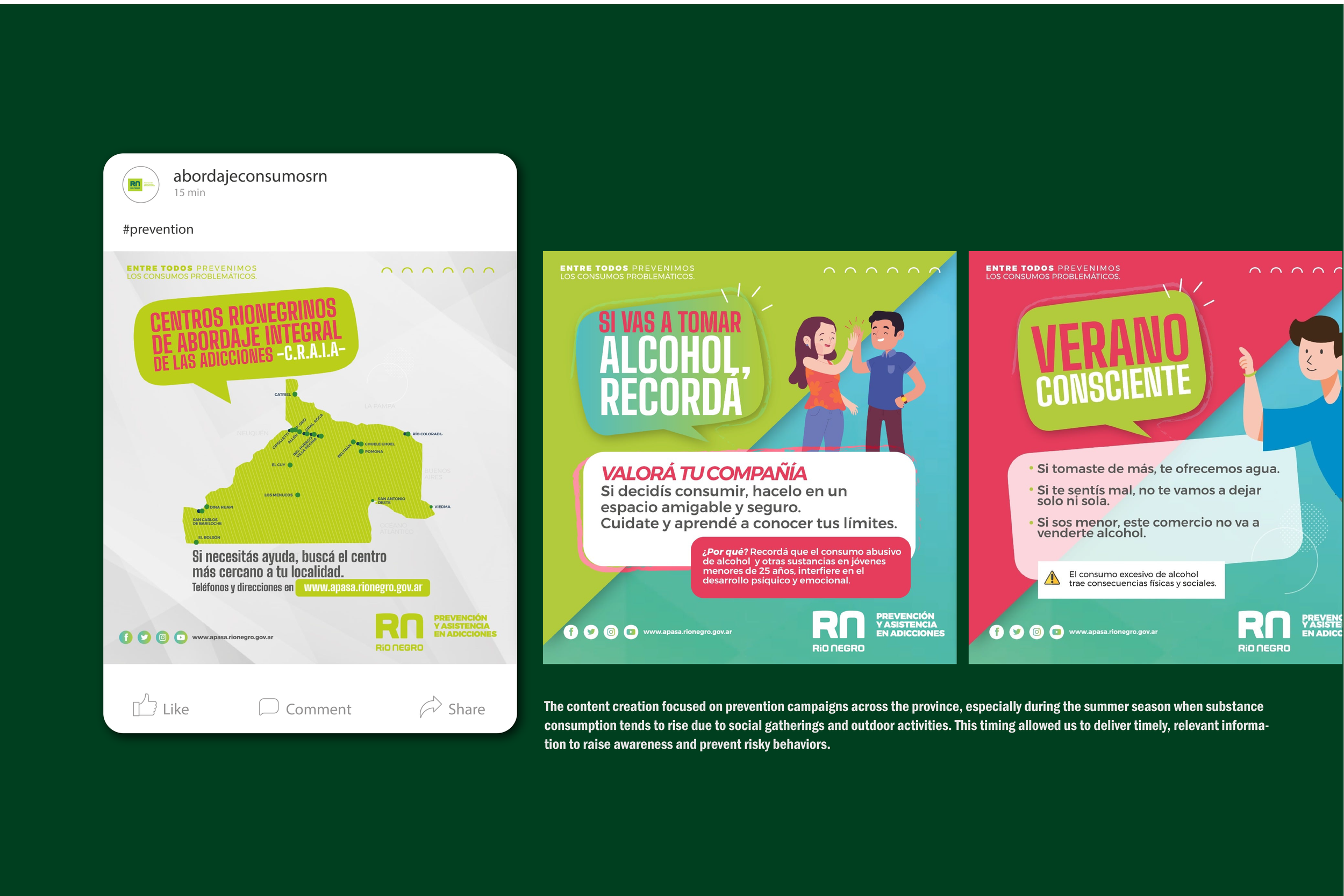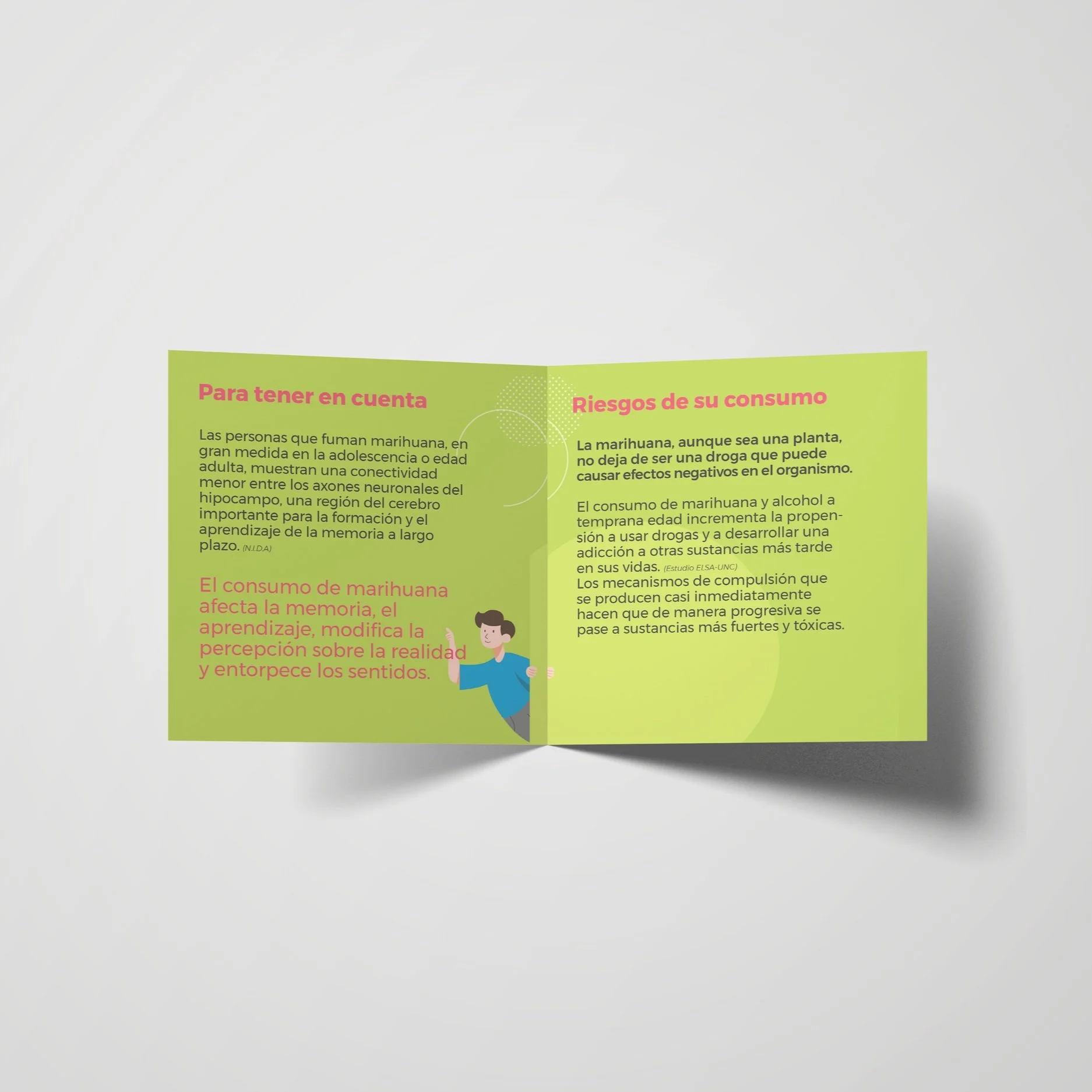Strategic Health Communication for Addiction Prevention
The Addiction Prevention Agency is an autonomous entity under the Government of Río Negro, operating independently from other departments. It is responsible for prevention, education, training, and the dissemination of information related to addictions, substance use, and associated challenges.
During my four years with the agency, I worked as a graphic designer, communications coordinator, and content writer, supporting its mission through daily information campaigns on social media and the agency’s website, as well as through in-person training and awareness initiatives in schools, institutions, and government offices. This role allowed me to contribute to meaningful public health initiatives by researching and ensuring clear, accessible communication while maintaining the sensitivity required by the topic and adapting messages to different audiences.
This showcase highlights some of the campaigns developed within the department. All work was guided by the Río Negro brand guidelines, ensuring alignment with established rules regarding branding, color, typography, and governmental standards.
Development of Brochures on Problematic Drug Use and Prevention
These brochures address issues related to drug use and prevention, tailored to specific events, seasons, and emerging challenges identified through fieldwork. Each edition is carefully designed to target the relevant audience and topics, promoting updated strategies and effective actions to tackle these problems.
The brochures, particularly those focusing on alcohol consumption, were distributed in schools, hospitals, community health centers, and youth support spaces—targeting the specific groups the agency aimed to reach. They provided adolescents with practical advice on how to respond in situations involving substance use, how to support friends struggling with consumption, and where to seek help if they find themselves under the influence and in danger. Additionally, each brochure included a QR code linking to information about support centers located throughout the province.
During the summer of 2019/20, a targeted awareness campaign was developed to prevent substance use and provide information about various substances. The campaign was distributed through tourist centers across the province and included different on-site interventions with agency staff educating the public about this topic.
Posters and brochures were also distributed to local businesses, where merchants were trained on how to assist individuals in situations of consumption, such as offering bottled water if needed, and informing users that these businesses served as safe spaces in case help was required.
The campaign was very well received, with strong participation from adolescents who actively engaged in the activities.
First Communication Project: Substance Awareness Campaign
Upon joining the communication team, I was assigned the task of developing the agency’s first substance awareness campaign. This campaign was based on survey data collected across the province, targeting an age range of 18 to 56 years. The survey examined the impact of various substances, comparing legal and illegal drugs and their effects on the body. It also explored consumption behaviors and frequency.
The campaign was launched in public spaces and supported by an online presence across the agency’s social media channels, primarily Facebook and Instagram. This initial effort allowed us to gather valuable audience insights that the agency previously lacked, including demographic data such as age and gender distribution of followers on social media.
Through targeted paid advertising, the campaign reached a significant portion of the population. While the topic was sensitive and relatively new for the region, the campaign served as an important first step in establishing the agency’s presence and communication strategy within the community.
Summer Awareness Campaign on Substance Use |2019/20|
Development of Data Presentation Slides
As part of my role, I prepared presentation slides for government meetings, national conferences, and events. This involved collecting data from multiple departments, analyzing it, and converting it into clear, comprehensible graphics that conveyed statistics, activities, impacts, and the scope of the department’s work. These presentations enabled stakeholders and audiences to readily understand the agency’s progress and outcomes.
Design of Official Fleet Vehicle Wraps
As part of the agency’s brand reinforcement strategy, I developed the design for the official fleet vehicle wraps used across provincial centers and at national events. These designs served to promote the agency while strengthening its identity and visibility within the community.
Development of Branded Merchandise and Clothing
As part of the agency’s communication efforts, I developed branded merchandise and clothing within the framework of the government’s brand guidelines and licensing requirements. These included clothing for agency staff and items for events and seasonal campaigns, such as caps, sunshades, and t-shirts for summer sports events, supporting the promotion of physical activity while strengthening the agency’s visibility within the community.
Support for the Comahue Psychiatry and Addictions Congress
The agency hosted an annual national event, the Comahue Psychiatry and Addictions Congress. During my time in the department, I contributed to this congress by designing signage, promotional materials, and content, as well as developing slides to support presentations and communication throughout the event.
Conclusion
Working at the Addiction Prevention Agency was a formative experience that showed me how design and communication can contribute meaningfully to public health and social change. I learned to adapt complex, sensitive topics into clear and accessible messages, developing a deep understanding of user behavior and language in a field that was initially unfamiliar to me.
I grew from being a graphic designer into a communications coordinator, collaborating with a team of dedicated professionals to build a communication strategy that reached and respected diverse audiences. This role challenged me to combine creativity with empathy and data driven decisions, shaping the way I now approach design and storytelling.
By the time I left, the agency had expanded its communication channels, established a clear brand voice and visual identity, and created a foundation for future initiatives. I am grateful for the lessons learned and for the opportunity to see how design can truly make a difference in people’s lives.


















